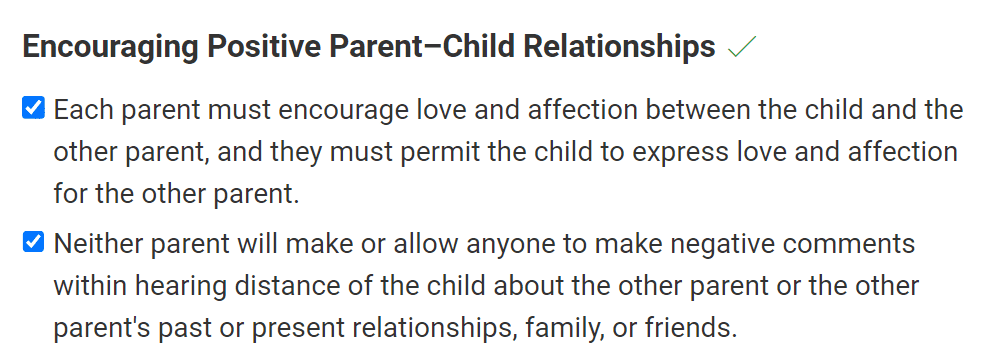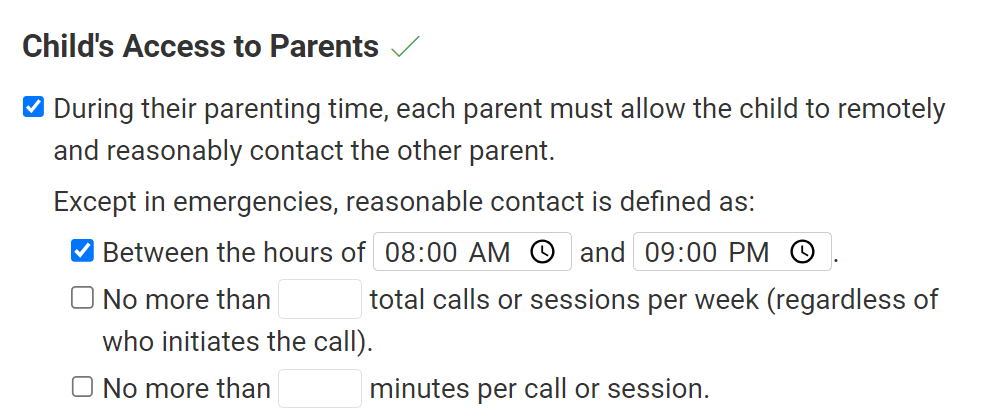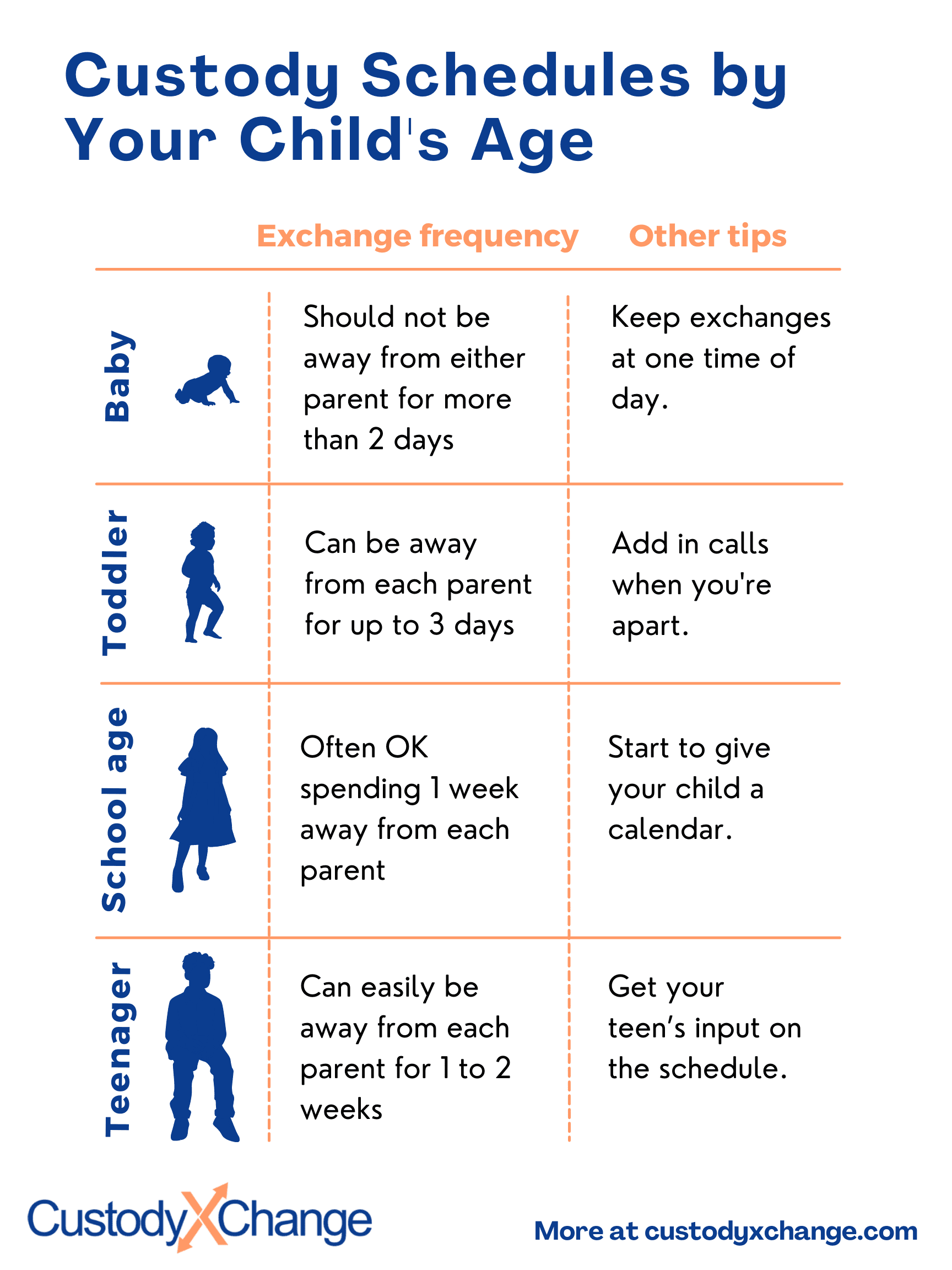Preschooler Parenting Plans and Custody Schedules
(3-5 years)
Making a parenting plan for a 3- to 5-year-old
A parenting plan for a preschooler has all of the information of a basic parenting plan but it is customized to fit the unique needs of a child aged 3 to 5 years.
Visualize your schedule. Get a written parenting plan. Calculate your parenting time.
Here are some things you need to know about preschool aged children to make your parenting plan more effective.
- Preschoolers do well with consistency and predictability. Your plan should allow your preschooler to keep a consistent routine.
- Preschoolers are attached to regular caregivers. Your plan should allow your preschooler to spend frequent time with both parents.
- Preschoolers may have trouble moving between homes. Your preschooler may be upset when switching between parents homes but become happy when settled in.
- Preschoolers benefit from time with other children away from parents. Your plan should include time for your preschooler to be in preschool or other settings with other children.
- Preschoolers go through a lot of developmental changes. You need to have a way to adjust your plan to accommodate your preschoolers new development.
- Preschoolers recognize anger and conflict. Your plan should have a way for the parents to deal with disagreements without exposing the preschooler to conflict.
A 3- to 5-year-old child may feel responsible for the parents' divorce. It is important that the parents reassure the child and also for the parents to be positive about the child spending time with the other parent. You may want to include a provision in your plan that states the parents should not speak negatively about the other parent in front of the child.

A preschooler will often tell a parent what the parent wants to hear regardless if it is true. If your child says something about the other parent you should discuss it with the other parent to learn the facts.
Preschoolers remember events and people and they may miss the parent who isn't with them. You can include a provision in your plan for telephone calls from the parent who isn't with the child. You can also have pictures of the other parent in the child's bedroom.

Making a custody schedule for a 3- to 5-year-old
Your custody schedule should give your preschooler frequent contact with both parents and give both parents the opportunity to provide routine caretaking.
Until your preschooler becomes comfortable in both parents' homes, you may need to name a primary home. You can slowly increase the length or number of visits to the other home, like a step-up parenting plan does.
As you make a schedule, you should consider how involved each parent was with the child before the separation and your child's temperament. Remember that preschool children can handle being away from a parent longer than younger children can.
When both parents work and the child goes to daycare, you may want to split the weekend so each parent has a full day with the child.

If one parent stays home with the child then you can give the weekend to the other parent along with some midweek time.

An alternating weekend schedule with overnights in the week can work well for a preschooler.

Many different schedules will work for a 3- to 5-year-old. Depending on your work schedule and the distance between the parents' homes, you may want to try the following schedules:
- The every extended weekend schedule or the every weekend schedule where your child is with one parent during the week and the other parent during the weekend.
- The 5-2 schedule or the 2-2-5-5 schedule where your child is with one parent for 5 days and the other parent for 2 days.
- The 2-2-3 schedule where your child spends 2 days with one parent, 2 days with the other parent and 3 days with the first parent.
- The alternating every 2 days schedule where your child alternates spending 2 days with each parent.
- The every 3rd day schedule where your child spends 2 day with one parent and 1 day with the other parent.
- The 4-3 schedule or the 3-4-4-3 schedule where your child spends 4 days with one parent and 3 days with the other parent.
- The alternating every week schedule where the parents alternate having the child for a week. You would probably want to include midweek and overnight visits to the other parent for a preschool aged child.
When one parent isn't comfortable with the daily routine of the child you can start with a visitation schedule that gives that parent a few visits during the week. When the parent and child are more comfortable and familiar you can increase the number of visits and add overnight visits.
You can make a holiday schedule that includes the holidays you want to celebrate and shows the time your preschooler spends with each parent for the holiday. Try to make holiday time about the same for each parent.

Development from 3 to 5 years old
Understanding some of the development of children ages 3-5 years old can help you make a better parenting plan and custody schedule for your preschooler.
3- to 5-year-olds typically sleep 11-13 hours a night and they drop their afternoon nap. As they grow they become more skilled at running, jumping, throwing a ball, kicking a ball, and pedaling a bike. They love to play outside and try new things physically.
3- to 5-year-olds can start to draw shapes and people, use blunt scissors, dress themselves, and use utensils when eating. They can also count, name colors, and respond to questions. Their language skills develop quickly and parents should talk to their children and read to them.
This is the age where children become more social. 3- to 5-year-olds like to spend time with children their own age and it is beneficial for children of this age to spend time playing without the parents. They can play games with rules, take turns, and start to lead in groups.
3- to 5-year-olds are very curious and will push physical, emotional, and behavioral limits. They need a safe and structured environment to explore.
Children this age want to please their parents and other important adults. They may talk back to parents or throw tantrums to get attention from parents or to get a reaction. Parents should deal with this in a calm manner or it will likely get worse.
Get help with preschooler parenting plans and schedules
Creating a plan and schedule on your own can feel overwhelming. You have to be sure to use airtight legal language and can't omit any required information.
The Custody X Change app takes the guesswork out of the equation. It walks you through each step of creating a parenting plan and helps you build a schedule piece by piece.

As a result, you get documents and calendars that meet your family's needs, as well as the court's standards.
For quick, reliable and affordable help making a parenting plan and custody schedule, turn to Custody X Change.
Visualize your schedule. Get a written parenting plan. Calculate your parenting time.
